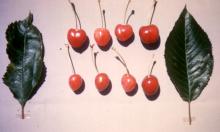Cause Believed to be of genetic origin. These disorders are bud propagated but not graft transmissible. Crinkle leaf, commonly found in the cultivars Bing and Black Tartarian, will reduce yields. Severely affected fruit with either disease is not marketable. These diseases were found on Bing in The Dalles area of Oregon in the mid-20th century.
Symptoms Both diseases result in misshapen leaves. Those of crinkle-affected trees are mottled, whereas leaves of deep suture affected limbs have a textured surface. Often, leaf margins are indented and serrated and blossoms are smaller and defective. In crinkle disease, the fruits are small, pointed, and often have a raised suture whereas the suture is severely indented in deep suture. These diseases may be only on a small branch or on almost all branches of a tree.
Cultural control Cut out affected branches where they join the trunk; cut out affected branches and rework with unaffected scion wood; or remove trees.
Reference Blodgett, E. C., and Nyland, G. 1976. Sweet cherry crinkle leaf, deep suture and variegation. (pp. 306-313) In, Virus Diseases and Noninfectious Disorders of Stone Fruits in North America. U.S. Dept. Agr., Agr. Handbook 437.




